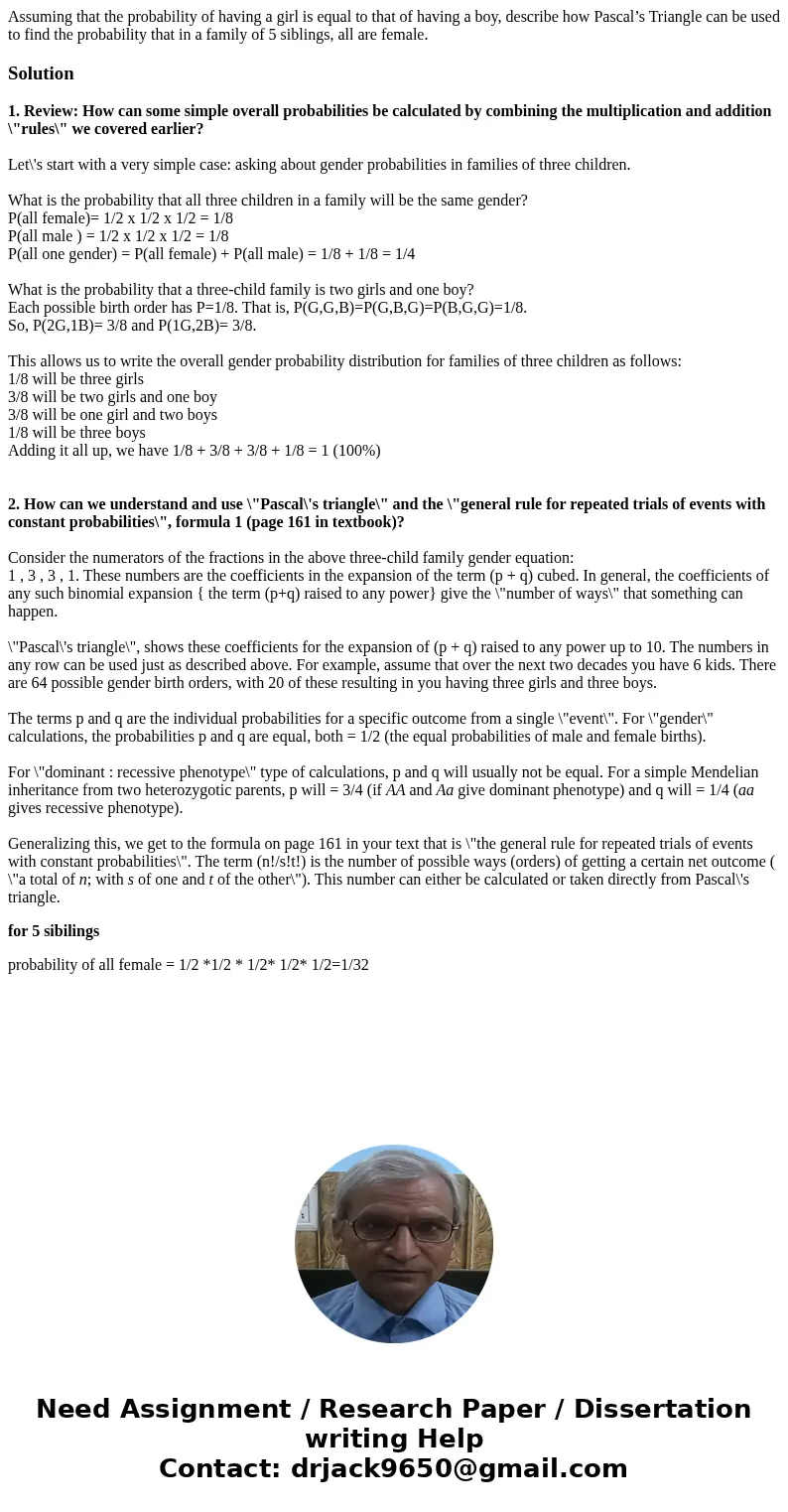Assuming that the probability of having a girl is equal to t
Assuming that the probability of having a girl is equal to that of having a boy, describe how Pascal’s Triangle can be used to find the probability that in a family of 5 siblings, all are female.
Solution
1. Review: How can some simple overall probabilities be calculated by combining the multiplication and addition \"rules\" we covered earlier?
Let\'s start with a very simple case: asking about gender probabilities in families of three children.
What is the probability that all three children in a family will be the same gender?
P(all female)= 1/2 x 1/2 x 1/2 = 1/8
P(all male ) = 1/2 x 1/2 x 1/2 = 1/8
P(all one gender) = P(all female) + P(all male) = 1/8 + 1/8 = 1/4
What is the probability that a three-child family is two girls and one boy?
Each possible birth order has P=1/8. That is, P(G,G,B)=P(G,B,G)=P(B,G,G)=1/8.
So, P(2G,1B)= 3/8 and P(1G,2B)= 3/8.
This allows us to write the overall gender probability distribution for families of three children as follows:
1/8 will be three girls
3/8 will be two girls and one boy
3/8 will be one girl and two boys
1/8 will be three boys
Adding it all up, we have 1/8 + 3/8 + 3/8 + 1/8 = 1 (100%)
2. How can we understand and use \"Pascal\'s triangle\" and the \"general rule for repeated trials of events with constant probabilities\", formula 1 (page 161 in textbook)?
Consider the numerators of the fractions in the above three-child family gender equation:
1 , 3 , 3 , 1. These numbers are the coefficients in the expansion of the term (p + q) cubed. In general, the coefficients of any such binomial expansion { the term (p+q) raised to any power} give the \"number of ways\" that something can happen.
\"Pascal\'s triangle\", shows these coefficients for the expansion of (p + q) raised to any power up to 10. The numbers in any row can be used just as described above. For example, assume that over the next two decades you have 6 kids. There are 64 possible gender birth orders, with 20 of these resulting in you having three girls and three boys.
The terms p and q are the individual probabilities for a specific outcome from a single \"event\". For \"gender\" calculations, the probabilities p and q are equal, both = 1/2 (the equal probabilities of male and female births).
For \"dominant : recessive phenotype\" type of calculations, p and q will usually not be equal. For a simple Mendelian inheritance from two heterozygotic parents, p will = 3/4 (if AA and Aa give dominant phenotype) and q will = 1/4 (aa gives recessive phenotype).
Generalizing this, we get to the formula on page 161 in your text that is \"the general rule for repeated trials of events with constant probabilities\". The term (n!/s!t!) is the number of possible ways (orders) of getting a certain net outcome ( \"a total of n; with s of one and t of the other\"). This number can either be calculated or taken directly from Pascal\'s triangle.
for 5 sibilings
probability of all female = 1/2 *1/2 * 1/2* 1/2* 1/2=1/32

 Homework Sourse
Homework Sourse